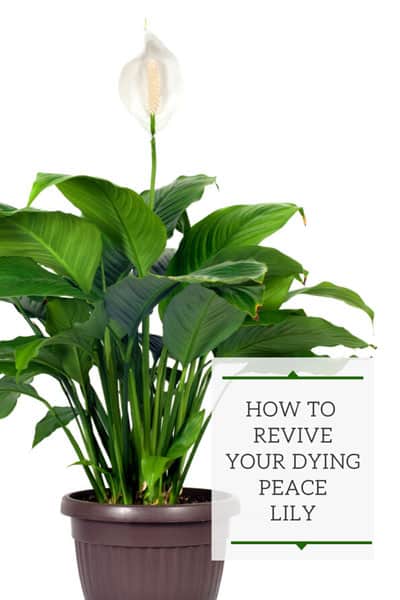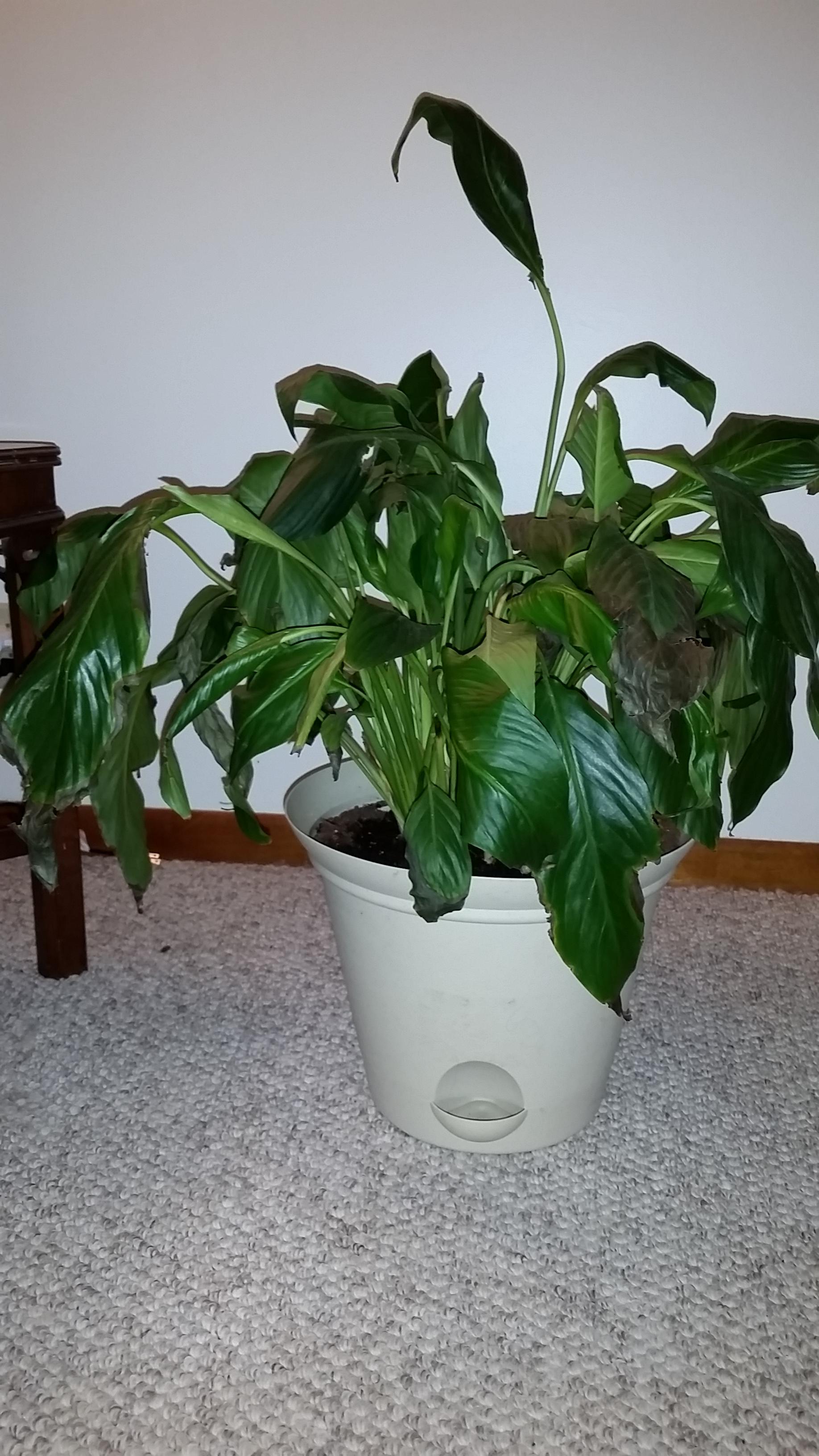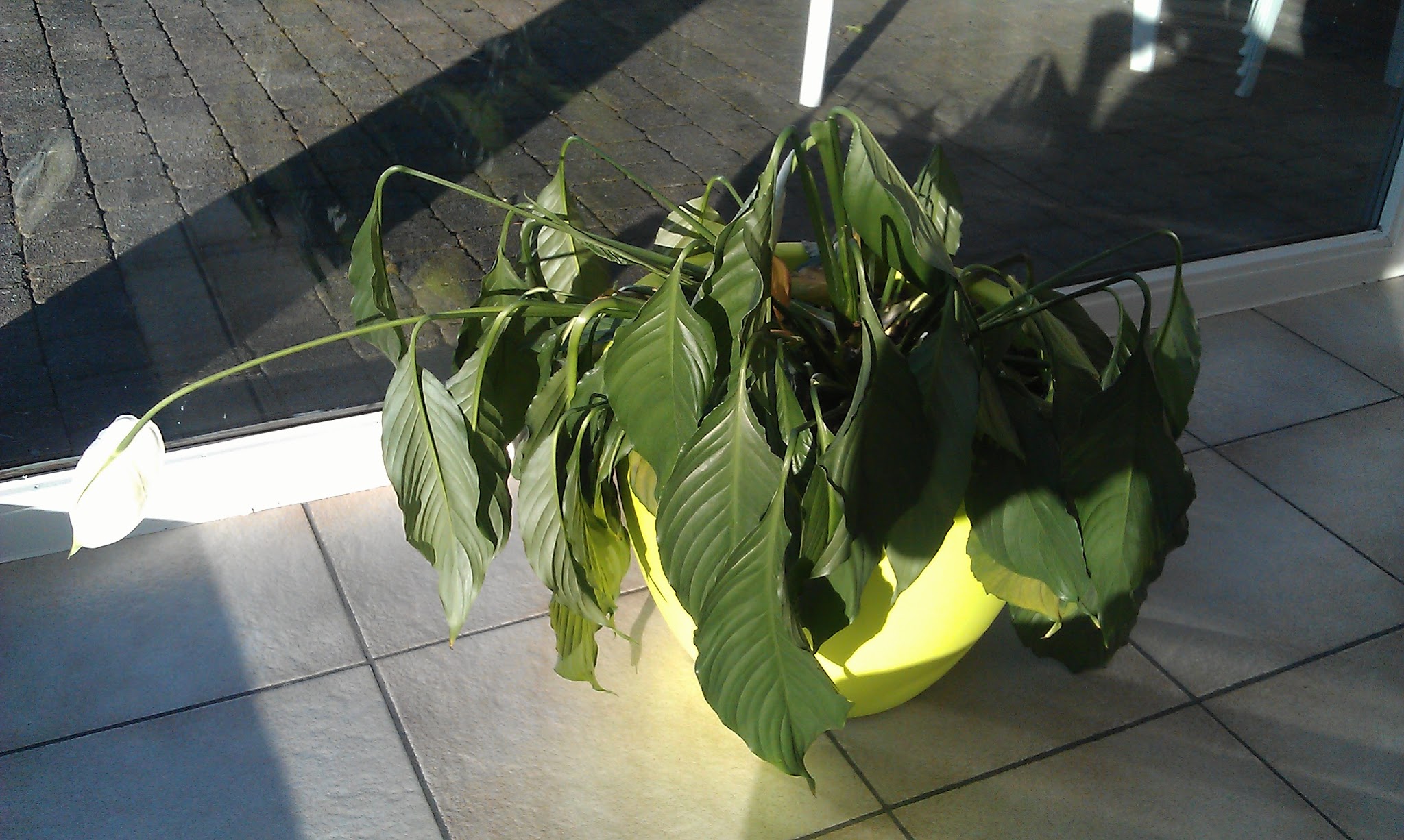The main cause of dying peace lilies is typically drought stress, which is brought on by underwatering and low humidity and manifests as a wilting plant with browning leaves. The yellowing and withering appearance of peace lilies is brought on by over watering, bad drainage, and a lack of nutrients.
Tropical plants called peace lilies flourish in shaded, wet, well-draining forests with warm temperatures (bright indirect light is optimal).
In order to revive peace lilies, it is important to mimic some of their natural conditions, such as higher humidity, shade from direct sunlight, and evenly moist soil. If a peace lily is dying, it is typically because it is residing in conditions that are contrary to its native habitat.
If your peace lily is wilting, going yellow, browning, or becoming black, keep reading to learn how to apply the remedies to save it.
Table of Contents
Peace Lily Leaves Drooping Due to Drought Stress
- Symptoms include a generally drooping appearance and frequently curled-up leaves on the peace lily. The leaf tips frequently turn brown and, on sometimes, yellow.
- Low humidity, underwatering, and water-repellent soil are the causes.
If the leaves of your peace lily are drooping, the most likely cause is drought stress brought on by underwatering or low humidity.
Native to the Americas and Asia, peace lilies are topical plants that flourish in forested areas with regular rainfall and moderately high humidity.
To prevent stress, the soil should be kept evenly moist and shouldn’t be allowed to considerably dry out.
At least once a week, peace lilies often need to be watered with a particularly generous soak so that water drips out the bottom of the pot. By doing this, you can be confident that the moisture has gotten to the roots where it is needed.
While the peace lily thrives in humid forests, homes have a relatively low humidity level.
Air conditioning, forced air, or convection currents from heat sources, especially in the winter, rob leaves of moisture.
As a result, the plant dries out considerably more quickly and displays stress by drooping or wilting.
Overwatering can also cause peace lilies to droop.
Keep in mind that peace lilies also droop under stress from overwatering.
Feel the soil with your fingertips at the top of the pot and through the drainage holes at the bottom to determine the root of your peace lily’s drooping.
Drooping is caused by drought stress if the soil feels on the dry side and the humidity is low.
Overwatering and root rot are the causes if the soil feels wet or saturated to a depth of a few fingers at the top and at the bottom through the drainage holes.
How to Revive a Drooping Peace Lily
A drooping peace lily can be revived by temporarily mimicking some of the moist conditions of its natural habitat, to which it is accustomed, but also by giving it a nice soak.
- Place your peace lily in a bowl of water for 10 minutes if the soil feels dry. When soil dries out, it can occasionally reject water from the surface and keep moisture from penetrating to the roots. Soaking the soil enables the water to effectively permeate the soil, providing the roots with the essential hydration.
- Increase the number of times you water. After the initial soak, let the peace lily dry out for about a week while carefully monitoring the process. When properly watered, the soil should feel evenly moist (not saturated) to a finger’s depth and feel slightly dry to the touch on the surface between waterings. In most houses, watering once a week is ideal, but if your area is unusually hot and dry, you may want to change how frequently you water.
- Always give your peace lily a good soak when watering. When plants are watered infrequently and superficially, the water does not effectively penetrate the soil and reach the roots, leading to drought stress and drooping leaves. Always add enough water to the pot so that any extra water drips out the bottom. This makes sure that the soil is hydrated throughout the entire pot.
- Mist-spraying the foliage will help. Tropical plants called peace lilies thrive in wet woods. By misting the leaves with a spray bottle at least once every week, you can recreate this in your house and create a humid microclimate. If you reside in a dry area or during the winter, when heating causes houses to typically have dryer air, up the frequency of your misting. This mimics the humidity of the peace lily’s natural habitat and reduces transpiration, or the loss of water from the leaves, quickly.
- Keep the plant away from air currents and heat sources. Peace lilies favor stable conditions. Place your peace lily in an area of your house that is somewhat quiet because forced air and air conditioning systems can dry out the leaves.
After a thorough soak, the peace lily should recover from its drooping appearance.
The peace lily should appear significantly healthier after suffering from drought stress after 2 or 3 cycles of irrigation and continuous misting.
(For further information on watering best practices, see my post on how often and how much to water peace lilies.)
Peace Lilies with Brown Spots or Streaks on the Leaves
- Brown patches or streaks on the leaves, frequently accompanied by leaf curling, and sometimes some leaf yellowing are the symptoms.
- Too much direct sun is a cause. Usually happens when peace lily is moved from a shaded place to a sunny area.
If the leaves of your peace lily have acquired brown streaks or blotches, this is a sign of sunburn.
Tropical plants called peace lilies thrive in the shade of forested cliffs.
As a result, when exposed to direct sunlight, its leaves are susceptible to damage and burning.
It is frequently simple to determine if too much sun is the cause of your brown leaves because they frequently develop spots or streaks on the leaves facing the most sun while remaining green on the leaves facing the least sun.
How To Revive Peace Lilies With Sunburnt Brown Spots
Peace lilies prefer brilliant indirect light over full sun or a lot of direct light.
It is best to refrain from trimming any leaves at first because doing so can put the plant under more stress.
If the leaves are curled, water the peace lily once a week to keep the soil moist and spritz the foliage to simulate the humidity of their tropical habitat. If the leaves are not curled, do not water the peace lily.
Trim back any leaves that are noticeably brown after new growth appears so that there are healthy, green leaves.
It may take some time for the plant to recover because peace lilies grow slowly.
If you move a peace lily, make sure to place it in bright indirect sunlight to avoid direct sunlight burns.
The peace lilies are given ample energy to produce blossoms and are shielded from sunburn by bright indirect sunlight.
To learn how to treat peace lilies with brown leaf tips, see my post.
Peace lily Leaves Turning Yellow
- Symptoms. older leaves going yellow lower on the plant or yellowing leaves that are drooping and turning yellow.
- Causes. The most frequent causes of a yellow and drooping peace lily are over watering and moist soil, while older leaves turning yellow signify nutrient shortage.
Tropical plants like peace lilies thrive in environments with abundant rainfall.
However, if the soil surrounding the roots is flooded (as opposed to just equally moist), this might deprive the roots of oxygen, causing the lily to turn yellow and droop as a sign of stress and perhaps resulting in fungus and root rot.
Your peace lily’s roots may be in too-wet soil for the following reasons:
- Overwatering.
- dirt that drains slowly
- pots without a base hole for drainage.
- the use of saucers, trays, or ornamental outside pots that collect water and keep it from draining.
Feel the soil to a depth of a few fingers and the dirt at the bottom of the container via the drainage holes to determine if overwatering is the reason the peace lily is turning yellow.
There is too much water surrounding the roots if the soil feels soggy rather than damp.
If you have a peace lily in your garden for a long time and the roots have used up all the nutrients in the soil mix, you may notice that the bottom leaves are becoming yellow. This is typically a sign of a nutrient deficiency in nitrogen or another element.
Occasionally, too much fertilizer can turn leaves yellow if it is applied too frequently or in excess amounts.
Because peace lilies don’t require a lot of fertilizer, always use balanced, all-purpose houseplant fertilizer at half strength and follow the manufacturer’s instructions.
How To Revive Peace Lily with Yellow Leaves
- Reduce watering if you are watering more frequently than once per week. In order to prevent denying the roots oxygen and lower the risk of root rot, the soil’s surface should be completely dry between waterings. For the best moisture balance, the soil should feel equally moist to a depth of two fingers.
- In order for water to drain, make sure your peace lily is put in a pot with drainage holes. Check to see that the hole is not plugged by compacted earth or roots if you notice that the soil is draining slowly.
- Regular emptying of saucers, trays, and decorative pots is advised. To avoid water from pooling around the roots at the bottom of the pot and leading to root rot, if you have anything under the base of the pot that you keep empty after watering it, make sure it is removed.
- Apply fertilizer to peace lilies with yellow leaves near the base of the plant. Apply a half-strength home plant fertilizer regularly once a month in the spring and summer to guarantee good development. This guarantees that the peace lily can get the nutrition it needs. Always adhere to the manufacturer’s recommendations because fertilizer applied too frequently or in excess concentration will cause leaf yellowing and impede flowering, which is why half-strength applications are typically preferable for peace lilies.
The lily has a chance to recover once you have reduced watering and made sure that extra water may drain from the pot.
However, if the lily has been in standing water for a while, this is likely to result in root rot, making it difficult to resuscitate the peace lily.
When given some fertilizer, peace lilies that have turned yellow because of a nutritional shortage typically react well and can appear better in the months that follow.
Peace Lily Turning Black
- If the leaves of your peace lily turn black, it’s usually because of the cold, either from a dip in temperature or from cold drafts.
- However, excessive watering and a number of fungi can cause peace lilies to turn black.
- Due to their dormancy, fertilizing lilies in the winter might turn them black. Only apply fertilizer at half strength in the spring and summer.
Peace lilies enjoy warmer temperatures because they are native to tropical settings.
Typically, a room’s temperature should be between 65°F and 75°F (18°C and 23°C) during the day and up to 10°F colder at night for peace lilies to survive comfortably.
However, if the temperature is below 50°F (10°C) for an extended period of time, peace lilies might turn black.
Any leaves that have turned noticeably black should be removed because they are no longer useful and don’t recover.
However if you are left with some healthy appearing growth after trimming away dark leaves the peace lily can recover.
To prevent the peace lily’s leaves from becoming black, keep the space warm and do not let the temperature drop below 50°F (10°C).
Sometimes leaves can be in contact with icy windows in Winter which turns the leaves black so be careful where you locate the peace lily.
Whilst overwatering causes drooping and turns the leaves yellow it can also cause the leaves to turn black as it fosters the conditions for fungal disease infections.
Cut back any black leaves with a sterile pair of pruners.
After each cut, wipe the pruners with a cloth dipped in disinfectant to stop the fungus from spreading to otherwise healthy growth.
Reduce watering to once a week, and make sure that any extra water may easily drain from the pot’s bottom.
The degree of the fungus infection determines whether the peace lily will recover or not.
The peace lily can recover if you continue using the best watering techniques and refrain from spraying the leaves for the time being.
Key Takeaways:
- A dying peace lily is typically caused by underwatering or low humidity as a result of indoor air currents. Drought stress causes peace lilies to droop and turn brown with a withering appearance. Yellow leaves on a dying peace lily indicate overwatering or nutrient deficiency.
- Peace lilies can develop brown spots or streaks because to too much direct sun. Indirect, strong light is best for growing peace lilies.
- Due to inadequate nourishment and excessive watering, peace lilies become yellow. Scale back the watering to once per week and ensure surplus water may escape from the bottom of the pot to revitalize the plant. In the Spring and Summer, use fertilizer at half strength once a month to revive yellow leaves that have become dormant from nutrient deficiency.
- The leaves of peace lilies turn black because of the cold and a fungus. To prevent overwatering and to keep peace lilies from freezing, place them in a room with stable temperature. Cut away any dark leaves with a sterile pair of pruners. The peace lily can be revived with careful attention.
FAQ
Will my peace lily come back to life?
Peace Lilies frequently come back to life after thoroughly hydrated, a quality that helps give them a forgiving reputation. Don’t take the plant’s “talking” to humans about being thirsty too far, though.
How often should I water my peace lily?
around once every week
Should I cut dying leaves off my peace lily?
A peace lily can be pruned anywhere, not just on the bloom stems. On sometimes, leaves turn yellow and begin to shrivel. Underwatering or excessive light may be to blame, but it could also be simply old age. If any of your leaves are changing color or drying out, just cut the problematic leaves away at their base.
What does an overwatered peace lily look like?
Widespread yellowing leaves, brown leaf tips, generalized drooping, leaf spot infections, and brown, mushy roots are the principal signs of an overwatered Peace Lily. Major causes of overwatering include overpotting, soil that doesn’t drain well, and regular watering.
Why is my peace lily dying?
The main cause of dying peace lilies is typically drought stress, which is brought on by underwatering and low humidity and manifests as a wilting plant with browning leaves. The yellowing and withering appearance of peace lilies is brought on by over watering, bad drainage, and a lack of nutrients.



